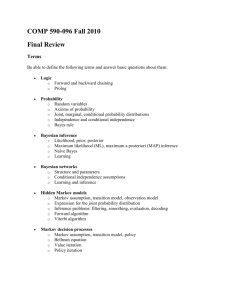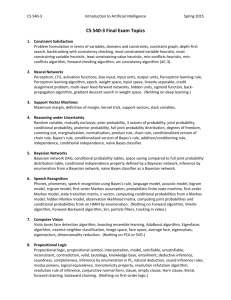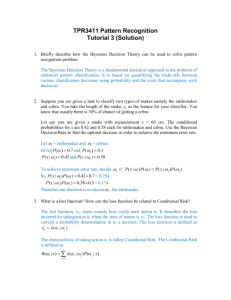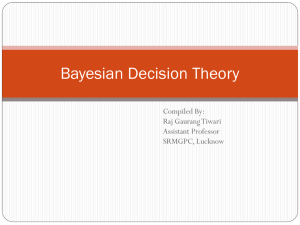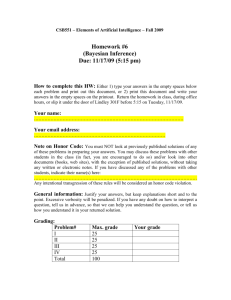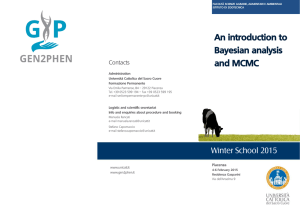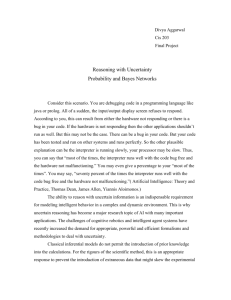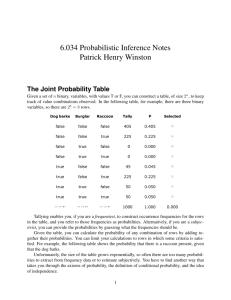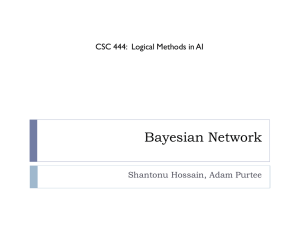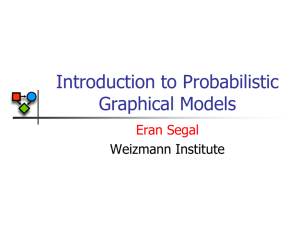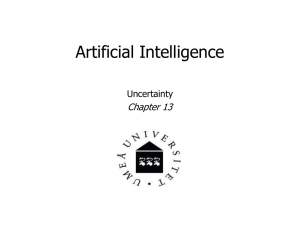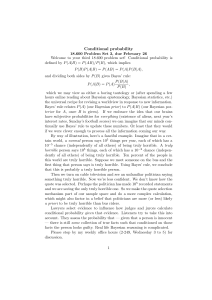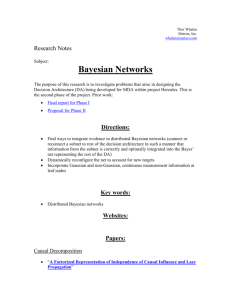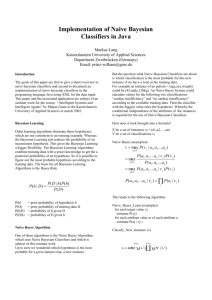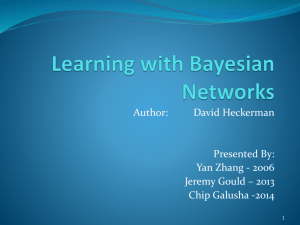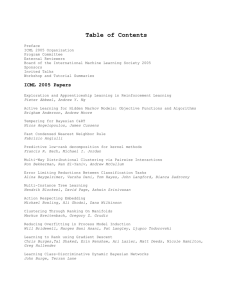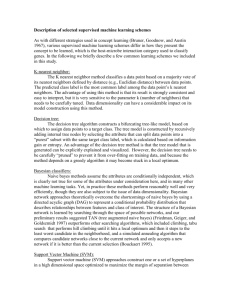DOC
advertisement
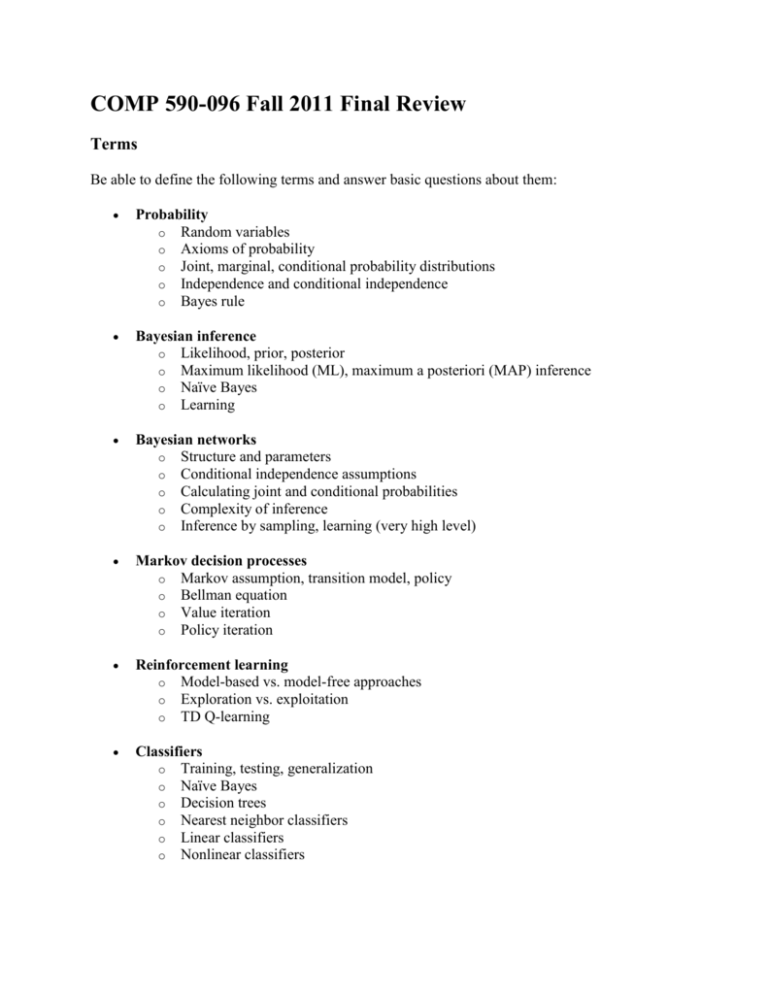
COMP 590-096 Fall 2011 Final Review
Terms
Be able to define the following terms and answer basic questions about them:
Probability
o Random variables
o Axioms of probability
o Joint, marginal, conditional probability distributions
o Independence and conditional independence
o Bayes rule
Bayesian inference
o Likelihood, prior, posterior
o Maximum likelihood (ML), maximum a posteriori (MAP) inference
o Naïve Bayes
o Learning
Bayesian networks
o Structure and parameters
o Conditional independence assumptions
o Calculating joint and conditional probabilities
o Complexity of inference
o Inference by sampling, learning (very high level)
Markov decision processes
o Markov assumption, transition model, policy
o Bellman equation
o Value iteration
o Policy iteration
Reinforcement learning
o Model-based vs. model-free approaches
o Exploration vs. exploitation
o TD Q-learning
Classifiers
o Training, testing, generalization
o Naïve Bayes
o Decision trees
o Nearest neighbor classifiers
o Linear classifiers
o Nonlinear classifiers
Sample exam questions
1. Use the axioms of probability to prove that P(¬A) = 1 – P(A).
2. A couple has two children, and one of them is a boy. What is the probability of the other
one being a boy?
3. Consider the following joint probability distribution:
P(A = true, B = true) = 0.12
P(A = true, B = false) = 0.18
P(A = false, B = true) = 0.28
P(A = false, B = false) = 0.42
What are the marginal distributions of A and B? Are A and B independent and why?
4. What is the relationship between the Boolean satisfiability (SAT) problem and Bayesian
network inference? How can we find an approximate solution to the SAT problem by
approximate Bayesian network inference?
5. We have a bag of three biased coins, a, b, and c, with probabilities of coming up heads of
20%, 60%, and 80%, respectively. One coin is drawn randomly from the bag (with equal
likelihood of drawing each of the three coins), and then the coin is flipped three times to
generate the outcomes X1, X2, and X3.
a. Draw the Bayesian network corresponding to this setup and define the necessary
conditional probability tables (CPTs).
b. Calculate which coin was most likely to have been drawn from the bag if the
observed flips come out heads twice and tails once.
6. Consider the “Burglary” Bayesian network.
a. How many independent parameters does this network have? How many
independent entries does the full joint distribution table have?
b. Is this network a polytree?
c. If no evidence is observed, are Burglary and Earthquake independent?
d. If we observe Alarm = true, are Burglary and Earthquake independent? Justify
your answer by deriving whether the probabilities involved satisfy the definition
of conditional independence.
7. Two astronomers in different parts of the world make measurements M1 and M2 of the
number of stars N in some small region of the sky, using their telescopes. Normally, there
is a small probability e of error by up to one star in each direction. Each telescope can
also (with a much smaller probability f) be badly out of focus (events F1 and F2), in which
case the scientist will undercount by three or more stars (or if N is less than 3, fail to
detect any stars at all).
a. Draw a Bayesian network for this problem.
b. Write out a conditional distribution for P(M1 | N) for the case where N {1,2,3}
and M1 {0,1,2,3,4}. Each entry in the conditional distribution table should be
expressed as a function of the parameters e and/or f.
c. Suppose M1 = 1 and M2 = 3. What are the possible numbers of stars if you assume
no prior constraint on the values of N?
d. What is the most likely number of stars, given these observations? Explain how to
compute this, or if it is not possible to compute, explain what additional
information is needed and how it would affect the result.
8. Consider the following 4x3 world, with transition model as explained in class. Calculate
which squares can be reached from (1,1) by the action sequence [Up, Up, Right, Right,
Right] and with what probabilities.
9. Consider the following game, called “High/Low”. There is an infinite deck of cards, half
of which are 2’s, one quarter are 3’s, and one quarter are 4’s. The game starts with a 3
showing. After each card, you say “High” or “Low,” and a new card is flipped. If you are
correct, you win the points shown on the new card. If there is a tie, you get zero points. If
you are wrong, the game ends.
a. Write down the transition model and the reward function for this game.
b. Draw the expectimax tree for the first two rounds of this game and write down the
expected utility of every node (use a discount factor of 1). What is the optimal
policy assuming the game only lasts two rounds?
